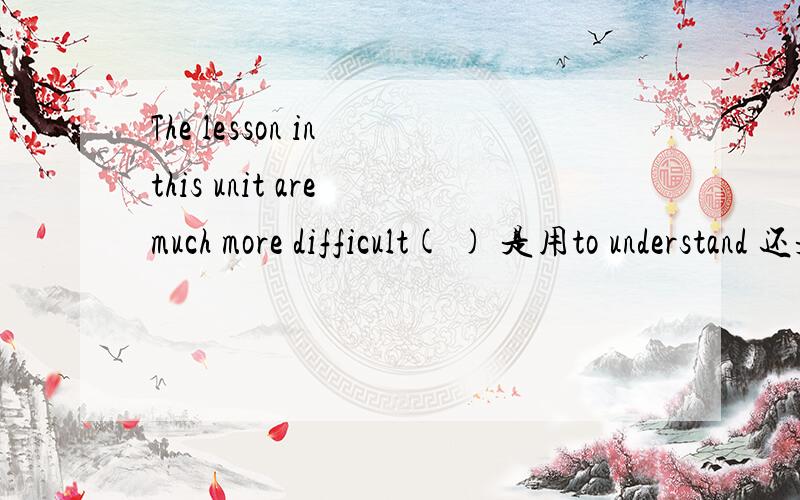The lesson in this unit are much more difficult( ) 是用to understand 还是to be understand 为什么?
来源:学生作业帮助网 编辑:作业帮 时间:2024/04/29 03:37:13

The lesson in this unit are much more difficult( ) 是用to understand 还是to be understand 为什么?
The lesson in this unit are much more difficult( ) 是用to understand 还是to be understand 为什么?
The lesson in this unit are much more difficult( ) 是用to understand 还是to be understand 为什么?
用【to understand】 .
解释:主动表被动.再例如:
The food is delicious 【to taste】.
【补充说明:】
某些“be+形容词+to do”结构中的不定式通常要用主动形式表示被动意义:
The question is difficult to answer. 这问题很难回答.
Your writing is impossible to read. 你的书写没法认.
Do you think the water is safe to drink? 你认为这水喝起来安全吗?
【注】①这类结构的特点是句子主语就是其后不定式的逻辑宾语,按理说其中的不定式要用被动形式,但习惯上却要用主动表被动.这类形容词常见的有awkward, convenient, dangerous, difficult, easy, hard, impossible, interesting, nice, pleasant, safe, tough, tricky, unpleasant 等.
② 有时形容词后跟有名词,在名词后用作定语的不定式用主动形式表示被动意义:
It’s a difficult book to read. 那是一本难读的书.
It is a pleasant thing to remember. 这是一件值得记住的愉快的事.
③ 有少数用于类似结构的形容词(如fit, ready, free等),其中的不定式用主动式和被动式均可:
The water is not fit to drink [to be drunk]. 这水不适合饮用.
The letters are ready to post [to be posted]. 这信已准备好可以寄了.
选to understand(很难理解) 。to be understand是 变得很难理解。
当不定式与前面的名词有动宾关系,又与句中另一名词或代词构成主谓关系时,该不定式用主动形式表示被动意义。
to understand
固定句型
比如说 I have a lot of homework to do.
“to be understood ”。 因为主语是“The lesson in this unit”,它被人所理解,应该用被动语态。
to understand,因为这是固定句型,主动表被动。形容词后都是用不定式来表被动的